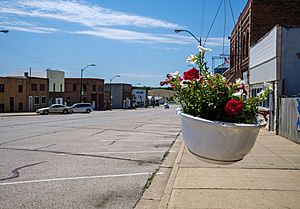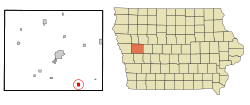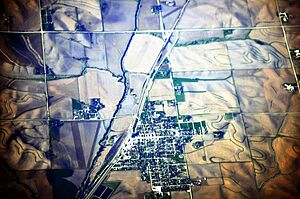Manilla, Iowa facts for kids
Quick facts for kids
Manilla, Iowa
|
|
|---|---|

Main Street
|
|

Location of Manilla, Iowa
|
|
| Country | |
| State | |
| County | Crawford |
| Area | |
| • Total | 1.06 sq mi (2.75 km2) |
| • Land | 1.06 sq mi (2.75 km2) |
| • Water | 0.00 sq mi (0.00 km2) |
| Elevation | 1,319 ft (402 m) |
| Population
(2020)
|
|
| • Total | 775 |
| • Density | 729.07/sq mi (281.40/km2) |
| Time zone | UTC-6 (Central (CST)) |
| • Summer (DST) | UTC-5 (CDT) |
| ZIP code |
51454
|
| Area code(s) | 712 |
| FIPS code | 19-48855 |
| GNIS feature ID | 2395830 |
Manilla is a small city in Crawford County, Iowa, United States. It is located along the West Nishnabotna River. In 2020, the city had a population of 775 people.
Contents
History of Manilla
Manilla is working to attract more people to live there. The city offers free land and property tax breaks. This helps new residents settle down and build homes.
Geography of Manilla
Manilla covers a total area of about 1.03 square miles (2.75 square kilometers). All of this area is land, with no major bodies of water inside the city limits.
Population and People
| Historical populations | ||
|---|---|---|
| Year | Pop. | ±% |
| 1890 | 526 | — |
| 1900 | 773 | +47.0% |
| 1910 | 875 | +13.2% |
| 1920 | 1,142 | +30.5% |
| 1930 | 1,032 | −9.6% |
| 1940 | 1,040 | +0.8% |
| 1950 | 1,035 | −0.5% |
| 1960 | 939 | −9.3% |
| 1970 | 943 | +0.4% |
| 1980 | 1,020 | +8.2% |
| 1990 | 898 | −12.0% |
| 2000 | 839 | −6.6% |
| 2010 | 776 | −7.5% |
| 2020 | 775 | −0.1% |
| Source: and Iowa Data Center Source: |
||
Manilla's Population in 2020
According to the 2020 census, 775 people lived in Manilla. There were 328 households and 204 families. The city had about 729 people per square mile.
Most residents, about 88.9%, were White. About 8.0% of the population identified as Hispanic or Latino.
The average age in Manilla was 46.1 years. About 24% of the residents were under 20 years old. About 23.5% were 65 years or older. The population was almost evenly split between males (50.2%) and females (49.8%).
Manilla's Population in 2010
In the 2010 census, Manilla had 776 people. There were 337 households and 214 families. The population density was about 753 people per square mile.
Most people, about 97.9%, were White. About 2.6% of the population was Hispanic or Latino.
The average age in the city was 47.7 years. About 20.9% of residents were under 18. About 26.7% were 65 or older. The population was 47.6% male and 52.4% female.
Education in Manilla
Students in Manilla attend schools within the IKM–Manning Community School District. The district used to have a middle school in Manilla, but it closed in 2014. The district's main office is still located in Manilla.
The Manilla Community School District started in 1889. The first school building had four classrooms. The first class graduated in 1904. A new school building opened in 1915, built with a $45,000 bond. In 1956, the school was renamed Manilla Community School.
Over the years, school districts merged. On July 1, 1992, the Manilla district joined with the IKM Community School District. Then, on July 1, 2011, IKM merged with Manning to form the current IKM–Manning Community School District.
See also
 In Spanish: Manilla (Iowa) para niños
In Spanish: Manilla (Iowa) para niños


